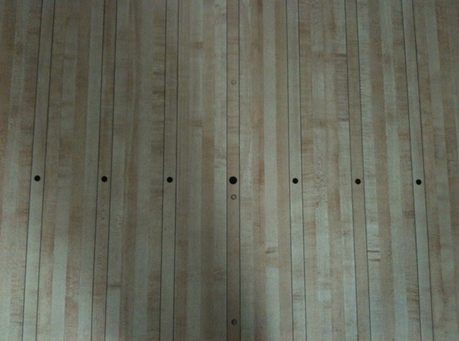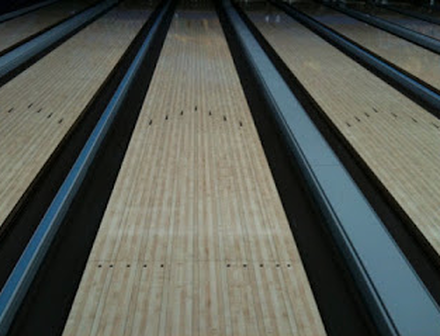|
The Bowling Lane consists of 39 boards across, each being about an inch wide. Years ago they were only made of wood but today they are mostly made of synthetic materials. The bowling lane is 42 inches wide, and 60 feet long. Each individual lane costs about $45,000 to have built in a bowling center and the amount of lanes can vary in each center, or House depending on how much space they have. But the average is about 26 lanes across. I bowled in a tournament in New Jersey once that had 100 lanes across, 50 being made by Brunswick, and the other 50 were made by AMF. These are two companies that make all kinds of bowling products. https://brunswickbowling.com/. https://en.wikipedia.org/wiki/AMF_Bowling The area on the lane that you first step onto is called the "Approach". When you walk onto the approach, there's a set of "Dots". Some bowling centers have 5 and some have 7 and each of the dots are equal to 5 boards. The dot in the center is also the center of the lane which is the 20th board, and is usually a bit larger than the other dots. Try to remember this. There is a line across the lane where the lane actually begins and is called the "Foul Line".There are 2 lights with sensors, on each side of the foul line, and if you cross this line on your ball release during league play, whatever pins you knocked down will not be counted in your score and the pins will be automatically be re-set. Your score will be marked as an "F" meaning that you fouled. Just passed the foul line there is another set of dots that line up with the first set, and even farther down the lane there is a set of "Arrows" which line up with both sets of dots.These dots and arrows are there to help you figure out where to stand, and to also help you figure out the best "Target" area to release your bowling ball. On the lane, a sheet of oil is put down by a special oiling machine. Years ago the oil was put down to protect the wood which the lanes were made of. Now it is put on for more of a challenge for each player, because different oil patterns are put down which I'll be discussing later on in my blog. At the end of the lane is a set of 10 pins which sit on the "Pin Deck". They are 15 inches high weighing about 3 pounds each, give or take a few ounces. The object of the game is to be successful in knocking all 10 pins down on the first try which is called a "Strike" and marked by an "X" in the score. If you are unsuccessful, you will only get one more try to knock down the remainder of the pins. If you are successful knocking down the rest of the pins, you will have made a "Spare" which is marked by a slash /. If you are unsuccessful in knocking all the pins down after your second try, then you will have a "Miss" or an "Open Frame" which is marked by a dash - (I will go into more detail on scoring a bit later in the blog). You will also notice the black area on each side of the lane. These are called "Channels" or "Gutters". They usually have "Gutter Guards" over these areas in children's leagues so they don't get a "Gutter Ball" or a miss. In an adult league, they are open and you want to avoid your best throwing the ball in the channel because that would mean that you have missed getting the strike or spare. Sometimes if a pin gets stuck in the channel, a bowler or the mechanic at the bowling center will have to roll a ball into the channel to get the pin out of the way. It can be a distraction to some bowlers. Check out my new ebook on Amazon/Kindle, available for only $14.99, "Let's Rev Up Those Bowling Scores"!! https://www.amazon.com/dp/B09ZSMB99G/ref=sr_1_2?crid=P3PQWHFB1WYS&keywords=lets+rev+up+those+bowling+scores&qid=1652035291&sprefix=lets+rev+up+those+bowling+scores%2Caps%2C76&sr=8-2 Join me back here again next week on when I'll be discussing "How to Get Started in Bowling-Part 2". I hope to see you then! Good Luck and High Scoring!!
0 Comments
Leave a Reply. |
AuthorHello!! My name is Joanie. Although I'm not a professional bowler, I have loved the sport for more than 45 years, averaged over 200 for several seasons, and learned quite a bit with research and experience. Archives
February 2023
Categories |


 RSS Feed
RSS Feed